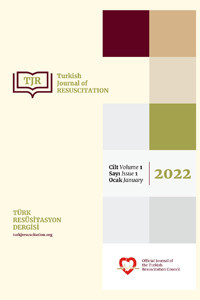DOKUZ EYLÜL ÜNİVERSİTESİ TIP FAKÜLTESİ HASTANESİNDE MAVİ KOD UYGULAMALARININ DEĞERLENDİRİLMESİ
Mavi kod, Kardiyopulmoner resüsitasyon, Hastane içi kardiyak arrest
EVALUATION OF CODE BLUE AT DOKUZ EYLUL UNIVERSITY, MEDICAL FACULTY HOSPITAL
___
- Chan PS, Krein SL, Tang F, Iwashyn TJ, Harrod M, Kennedy M. Resuscitation practices associated with survival after in hospital cardiac arrest. JAMA. 2016; 1(2):189-197.
- Birbiçer H, Keleş GT. Erişkin Kardiyopulmoner Resüsitasyonda Güncel Yaklaşımlar. 2018; 147.
- 3. Bradley SM, Liu W, Chan PS, Girotta S. Duration of resuscitation efforts for in-hospital cardiac arrest by predicted outcomes :Insights from Get With The Guidelines Resuscitation. 2017; 113-134.
- http://tr.wikipedia.org./wiki/hastane_acil_kod_sistemleri, Erişim Tarihi: 09.08.2012.
- Canural R, Gökalp N, Yıldırım K, Şahin M, Korkmaz A, Şahin N, Sağlık Hizmetlerinde Hasta Güvenliği: Mavi kod Uygulaması Uluslararası Sağlıkta Performans ve Kalite Kongresi Bildirileri Kitabı. Sağlık Bakanlığı, Ankara, 2009;772(2):525-40.
- Hasta ve Çalışan Güvenliğinin Sağlanmasına Dair Yönetmelik, Sağlık Bakanlığı. resmi gazete 27897, 2011.
- Holmberg M, Ross C, Chan SP, Duval-Arnould J, Grossestreuer AV, Yankama T, et all. Incidence of adult in-hospital cardiac arrest in the United States. Abstractpresentedat: American Heart Asscociation Resuscitation Science Symposium. Am. Hear. Assoc. Resusciation Sience Symp. 2018;138: A23
- Nolan JP, Soar J, Smith GB, Gwinnutt C, Parrott F, Power S, Rowan K. Incidence and outcome of in-hospital cardiac arrest in the United Kingdom National Cardiac Arrest Audit. Resuscitation. 2014; 85, 987–992.
- Andersen LW, Holmberg, MJ, Berg KM, Donnino MWD, Granfeldt A, In-Hospital Cardiac Arrest: A Review. JAMA 2019; 321, 1200–1210.
- Tezcan-Keleş G, Özbilgin Ş, Uğur L, Birbiçer H, Akın Ş, Kuvaki-Balkan B, et all. Evaluation of Cardiopulmonary Resuscitation Conditions in Turkey: Current Status of Code Blue. Turk J Anaesthesiol Reanim. 2021;49, 30–36.
- Topel A, İskit AT, Hacettepe Üniversitesi Sıhhiye Yerleşkesinde Kardiyopulmoner Arreste Yönelik Oluşturulan Mavi kod Uygulamasının Süreç ve Sonuçlarının Değerlendirilmesi. Epidemiyoloji Programı. Yüksek lisans tezi. 2016.
- Hillman K, Chen J, Cretikos M, Bellomo R, Brown D, Doig G. et all. Introduction of the medical emergency team (MET) system: a cluster-randomised controlled trial. Lancet. 2005; 365(9477), 2091-2097.
- Cooper SCJ. Predicting survival, in-hospital cardiac arrests: resuscitation survival variables and training effectiveness. Resuscitation. 1997; 35, 17–22.
- Murat E, Toprak S, Doğan DB, Mordoğan F. Hasta Güvenliğinde Mavi kod Uygulama Sonuçlarının Değerlendirilmesi. Med. Sci. 2014; 3(1):1002-12.
- Schultz SC, Cullinane DC, Pasquale MD, Magnant C, Predicting in- hospital mortality during cardiopulmonary resuscitation. Resuscitation. 1996; 33:1317
- Perman SM, Stanton E, Soar J, Berg RA, Donnino MW,Mikkelsen EM, et all. Location of in hospital cardiac arrest in the United States: variability in event rate and outcomes. American Heart Association Resusciation. 2016; 5(10): e003638.
- Benjamin EJ, Virani SS, Callaway CW, Chamberlein AM, Chang AR, Cheng, S. et all. Heart Disease and Stroke Statistics 2018 Update: a report from the American Heart Association. Circulation. 2018;137, e67–e492.
- Fernando SM, Tran A, Cheng W, Rochwerg B, Taljaard M, Vaillancourt C. et all. Pre-arrest and intra-arrest prognostic factors associated with survival after in-hospital cardiac arrest: systematic review and meta-analysis. BMJ. 2019; 367.
- Ayanian J. Heart disease in black and white. N Engl J Med. 1993; 329:656–658.
- Sandroni C, Nolan J, Cavallaro F, Antonelli M. In-hospital cardiac arrest: Incidence, prognosis and possible measures to improve survival. Intensive Care Medicine 2007, 237–245.
- Wang M, Huang W, Yen DH, Yeh E, Wu S, Liao H. The Potential Risk Factors for Mortality in Patients After In-Hospital Cardiac Arrest: A Multicenter Study. Front. Cardiovasc. Med. 2021; 8:630102
- Schwenzer KJ, Smith WT, Durbin CJ. Selective application of cardiopulmonary resuscitation im- proves survival rates. Anesth. Analg. 1993;76, 478–484.
- Paniagua D, Lopez-Jimenez F, Lon-Dono JC, Mangione CM, Fleisch- mann K, Lamas G. Outcome and cost-effectiveness of cardiopulmonary resuscitation after in-hospital cardiac arrest in octogenarians. Cardiology. 2002; (1):6-11
- Nadkarni VM, Larkin GL, Peberdy MA, Carey SM, Kaye W, Mancini M, et all. First documented rhythm and clinical outcome from in-hospital cardiac arrest among children and adults. JAMA. 2006; 295, 50–57.
- Stankovica N, Høybyea M, Holmberga MJ, Lauridsena GK., Andersen WL. Factors associated with shockable versus nonshockable rhythms in patientswith in-hospital cardiac arrest. Resuscitation. 2021; 158:166-174.
- Høybyea M, Stankovica N, Lauridsena KG, Holmberga MJ, Andersen WL, Granfeldt A. Pulseless electrical activity vs. asystole in adult in-hospital cardiac arrest: Predictors and outcomes. Resuscitation. 2021;165:50-57.
- Başlangıç: 2022
- Yayıncı: Resüsitasyon Derneği
DOKUZ EYLÜL ÜNİVERSİTESİ TIP FAKÜLTESİ HASTANESİNDE MAVİ KOD UYGULAMALARININ DEĞERLENDİRİLMESİ
Neslihan TÜTÜNCÜ KILIÇ, Bahar KUVAKİ, Şule ÖZBİLGİN, Mert İNCESU
Nurcan DORUK, Levent ÖZDEMİR, Aslınur SAGÜN, Bahar TAŞDELEN, Merve KÖK, Enes YEŞİLMEN
NEFESLE BAŞLAR YOLCULUK!: KARDİYOPULMONER RESÜSİTASYONDA TARİHSEL BİR GEZİNTİ
Aslı KARSLI KOÇ, Hatice Evren EKER, Çağla Etike BALİ, Anış ARIBOĞAN, Şule AKIN
ÇOKLU BAŞARILI RESÜSİTASYON VE AKUT KORONER SENDROMLU HASTAYA YAKLAŞIM
Tarık KAÇAR, Ali ALAGÖZ, Gönül TEZCAN KELEŞ
Y. Levent UĞUR, Murat ÖZÇELİK, Şule ÖZBİLGİN, Bahar KUVAKİ, Necati GÖKMEN
